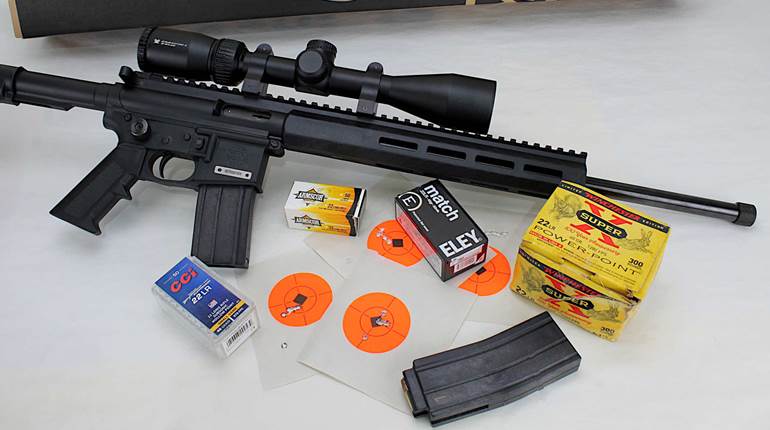
Lindberg AR-5A replica (top). From the collection of The Institute of Military Technology.The Lindberg replica disassembled just like the real ArmaLite AR-5A survival rifle (bottom).
Following the publication of the story “Survivor: The Unlikely Resilience of the AR-7,” a reader wrote:
“[The AR-7] is one of the most interesting arms ever marketed. However, it brought to mind some pleasant memories for me as a child. Does anyone remember the replica plastic toy AR-5 that was put out by, I believe, Lindberg toys in the 50's? I received one when I was only 10 years or so old, and was totally enchanted by its realism and functionality. It was a model of the AR-5 bolt action version, and could do anything the real one could do...except fire a round!”
While researching the AR-7 story I encountered one of these plastic replicas in the collection of The Institute of Military Technology at Knight’s Armament. Amongst the prototypes and production models of the AR-5 and AR-7 was a full-sized plastic replica of the Strategic Air Command’s (SAC) survival rifle, a little-known relic of ArmaLite history and a throwback to a time when guns joined cars and airplanes on the shelves of model stores.

Right-and left-side view of the Lindberg AR-5A replica, a full-scale plastic replica of the ArmaLite AR-5A rifle. When the replica was released the Strategic Air Command had recently officially adopted the ArmaLite as its survival rifle.
The buttplate of the Lindberg AR-5A replica marks it as a copy of the Strategic Air Command's official survival rifle.
The Lindberg AR-5A is a full-scale plastic replica of the ArmaLite AR-5A survival rifle, duplicating the original’s details down to the fiberglass texture of the stock, the detachable “Ronson Lighter” magazine and the working bolt action. Like the real thing, the Lindberg replica breaks down into four pieces so that the action, barrel and magazine can be stowed in the stock. The receiver is marked “ARMALITE AR-5A” with a serial number of 508 (within the 500-series of ArmaLite’s “A” version of the AR-5) and presumably the marking of the original AR-5 used to make the mold. Whereas the buttcap of the original is marked “ArmaLite AR-5A Hollywood, Calif. Patent Pending” the Lindberg model’s says “Replica of Official Strategic Air Command Survival Rifle By Fairchild.”
Like the original ArmaLite AR-5A, the Lindberg AR-5A replica disassembles into four pieces for storage in the stock.
The Lindberg AR-5A replica came in a box that featured an illustration, probably by lead Lindberg artist Raymond Gaedke, that showed a grim-faced SAC pilot, still in his flight helmet, crouching in the jungle and firing his AR-5, while enemy soldiers swarmed his downed B-47 Stratojet in the background.
The original box art for the Lindberg AR-5 replica. Photo courtesy of the International Plastic Modelers Society/USA. Used with permission from Round 2 LLC.
There was a booming plastic model craze in the 1950s. The easy-to-assemble and finish plastic modelling kits allowed children, and adults, the opportunity to replicate the rapidly advancing technology of the ‘50s, from the latest sports cars to jet-engine bombers.
The right side of the Lindberg AR-5A replica shows the company markings. 
The markings on the Lindberg AR-5A replica match those of the original ArmaLite AR-5A.
Paul W. Lindberg worked as model editor and designer for Popular Aviation magazine in the 1930s, penning detailed plans for making complex balsa wood and tissue paper aircraft models that were published in the magazine. Following World War II Lindberg transitioned to plastic models, helping to establish some of the early American plastic model kit companies and patenting many plastic model manufacturing techniques. By the early 1950s he had started his own company, Lindberg Products based in Skokie, Ill., offering model kits of military and civilian aircraft, automobiles, ships and trains. Lindberg’s “Flying Saucer” model would famously be used as a special effects prop in Ed Wood’s 1959 sci-fi film “Plan 9 from Outer Space.”
The Lindberg AR-5A replica (top) compared to an original ArmaLite AR-5A survival rifle (middle) and an early ArmaLite AR-7 rifle (bottom).
Guns were also part of the plastic model world with companies like Pyro, Life-Like and Premier making lines of firearms models, both in scaled kits that required assembly and full-sized working replicas. Some of the most famous firearms model kits were Best Plastics line of 1/3 scale firearms, which included a Winchester 1894, Savage 99 and a Mannlicher Schoenauer carbine.
In the contemporary world of orange plastic barrel plugs and fluorescent toy guns it may be hard for some to imagine sending your kid into the yard with a full-sized working replica of a firearm, but in the 1950s gun models allowed children to learn the history, technology and aesthetics of firearms in the same way that modelling introduced them to the world of planes, trains and automobiles.
The Lindberg AR-5A replica (top) disassembled just like the real ArmaLite AR-5A survival rifle (bottom).
The Lindberg AR-5A replica appeared around the same time the U.S. Air Force adopted the rifle in 1956. Model companies worked closely with aircraft and automobile manufacturers to release replicas of their products as soon as the real thing became public. Lindberg certainly had a relationship with Fairchild Aircraft and the replica was part of an ArmaLite/Fairchild promotional push of the AR-5 that included articles about the rifle in magazines like Popular Science. The plastic replica sold for $2.98.
Production numbers of the Lindberg AR-5A replica are unknown, but they certainly exceeded the two dozen or so AR-5s produced by ArmaLite. The models still show up from time to time, at estate sales or online auctions, their condition varying based on the amount of use by the children that they were intended for, and they sell for around $200.
A unique piece of ArmaLite and SAC history, the Lindberg AR-5A replica is also a reminder of a time when learning about guns was a common part of growing up.






































